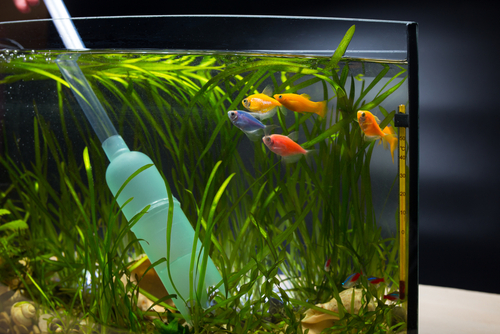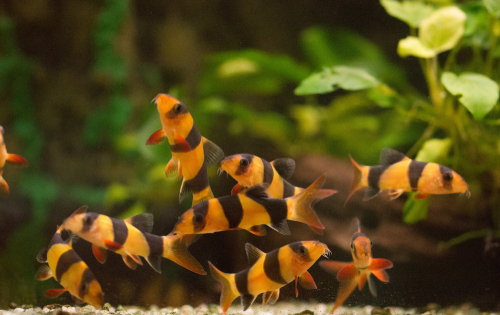Check out these other popular picks in this category:
- The Ultimate Guide to Setting Up Your First Fish Tank
- Tips To Keep Your Aquarium Fish Alive and Thriving
- Tips for Building an Underwater Tunnel
Welcome, fellow aquarists, to a guide that will revolutionize your fish tank maintenance routine! Are you tired of battling algae blooms and struggling to keep your aquarium crystal clear?
Look no further as we unveil the ultimate secrets on how to clean a fish tank.
Whether you’re a novice or a seasoned hobbyist, these expert tips and tricks will empower you to tackle the daunting task of aquarium cleaning with ease.
We’ll explore the concept of effortless aquariums, where you can let nature take the lead in maintaining a healthy and vibrant underwater environment.
These actionable tips will help you achieve an aquarium that practically takes care of itself. Let’s get started!
Contents
The Key Principles of Effortless Aquariums

Effortless aquariums depend on critical principles promoting natural balance and sustainability. Following these principles ensures a stable, low-maintenance tank that flourishes independently. Here are the foundational elements:
1. Choosing Sand Over Gravel:
Opt for sand as your substrate instead of gravel. Sand traps dirt and debris, preventing it from clouding the water column. Aim for approximately one pound or 500 grams of sand per gallon or 4L of water, creating a two-inch (5cm) deep layer.
2. Embracing Fish-Friendly Plants:
Incorporate aquatic plants into your aquarium. Not only do they add beauty and natural aesthetics, but they also contribute to the overall health of the tank.
Select plants that are compatible with your fish species and avoid ones that are prone to be eaten.
3. Introducing Microorganisms from Outdoors:
Enhance your aquarium’s ecosystem by bringing in microorganisms from the surrounding environment. Collect sand, plants, rocks, or wood from outside to introduce beneficial microbial communities.
These microorganisms are crucial in maintaining water quality and breaking down waste.
4. Avoiding Overfeeding and Overcrowding:

Overfeeding your fish leads to excess waste and poor water quality. Feed your fish the appropriate amount and avoid overcrowding the tank, as it can cause stress and compromise the well-being of your aquatic inhabitants. Remember that a healthy fish is a well fed hungry fish.
How Often to Clean Your Aquarium
Before discussing cleaning a fish tank, it’s essential to know that several factors determine how often you should carry out the exercise. As such, they are vital to consider before implementing any cleaning schedule.
For example, if you have a large aquarium, you only need to clean it a few times; large aquariums can take more waste than smaller ones. However, they also tend to hold more fish than smaller ones, and the waste accumulation rate may also increase, calling for more frequent cleaning.
Additionally, some fish generate waste in the tank much faster than others; some even have more toxic waste than others. If the species of fish you are raising generates waste at a fast rate, your aquarium cleaning should be more frequent.
How to Know When to Clean Your Aquarium
Although it’s great to have a schedule for cleaning your fish tank, you should be more flexible about the exercise. For instance, clean your aquarium regularly and when the need arises. Is there a general rule to tell you when to clean your tank?

- Watch out for evaporation: Water slowly evaporates from your tank, especially for warm-water fish. When your aquarium water levels are low, the remaining water may be dense with particles to scoop out.
- A cloudy aquarium may indicate problems with the water, and it may need to be changed as soon as possible, whether wholly or partially.
- You should regularly check all the equipment in your aquarium to ensure they are in good working condition. These include filters and pumps, which you may check for clogging particles, and lights.
- Monitor the water texture and purity; if the water is becoming thick or dense, then it’s going stale. Moreover, if it’s becoming colored, there are lots of waste particles accumulating in it, and it is time to change the water. Cleaning the tank itself may also be necessary if the walls have begun to brown out.
- You should also keep track of other vital factors like salinity and alkalinity to ensure the water is safe for the fish. If salinity or alkalinity levels become unfavorable, changing the water and cleaning the tank may be necessary.
Step-by-Step Guide to Creating an Effortless Aquarium
Now that we understand the principles, let’s walk through a step-by-step guide to creating an effortless aquarium:
Step 1: Prepare the Substrate
Start by removing any existing gravel and replacing it with sand. Aim for a two-inch (5cm) layer of sand, ensuring you rinse it thoroughly to remove dust particles.
This layer will act as a natural filter, trapping debris and promoting a healthier environment.
Step 2: Select Fish-Friendly Plants

Research and choose aquatic plants compatible with your fish species and tank conditions. Plants provide oxygen and natural hiding places and help maintain water quality by absorbing nitrates.
Consider diverse plant species to create a visually appealing and well-balanced ecosystem.
Step 3: Introduce Microorganisms
Collect a small amount of sand, plants, or other natural materials from a clean outdoor source. Rinse them carefully to remove any contaminants and introduce them into your aquarium.
These natural materials carry beneficial microorganisms that will help establish a robust and self-sustaining ecosystem.
Step 4: Establish Proper Feeding Practices
Feed your fish the appropriate amount of food for their species and size. Overfeeding can lead to excess waste and deteriorate water quality.
Monitor your fish’s feeding habits and adjust accordingly to ensure they receive adequate nutrition without causing waste-related issues.
Step 5: Maintain Water Quality

Regularly test and monitor the water parameters such as temperature, pH, ammonia, nitrite, and nitrate levels. Perform routine water changes to maintain optimal water quality and remove accumulated waste.
Avoid using harsh chemicals unless necessary, as they can disrupt the delicate balance of the aquarium’s ecosystem.
The Benefits of Effortless Aquariums
Effortless aquariums offer several benefits beyond their low-maintenance nature:
Visual Appeal:
A well-designed, effortless aquarium can be a stunning centrepiece in any room. The vibrant fish, lush plants, and natural aesthetics create a captivating display.
Educational Value:
Maintaining an effortless aquarium can be an excellent learning experience for children and adults.
Observing the interactions between fish and plants, understanding the ecosystem’s delicate balance, and witnessing nature at work fosters a deeper appreciation for aquatic life.
Relaxation and Stress Relief:

Watching fish glide through the water and plants sway in the gentle currents can calm the mind and body. Effortless aquariums provide a serene environment that promotes relaxation and reduces stress.
Final Thoughts on How to Clean a Fish Tank
By following the principles and steps outlined in this guide, you can create an effortless aquarium that thrives on the principles of nature.
With sand as the substrate, fish-friendly plants, natural microorganisms, and proper feeding practices, you’ll establish a self-sustaining ecosystem that requires minimal intervention.
Enjoy the beauty and tranquillity of your underwater world while letting nature do its magic!
Remember, while effortless aquariums require less maintenance, regular observation and occasional adjustments are still necessary to ensure the well-being of your aquatic inhabitants.
So embrace the wonders of nature, and dive into the world of effortless aquariums!
Happy fishkeeping!
Frequently Asked Questions
How often should I clean my fish tank
The frequency of cleaning your fish tank depends on various factors, including the size of the tank, the number and size of fish, the type of filtration system, and the overall water quality.
However, as a general guideline, we recommend performing regular maintenance on your fish tank at least once every 1-2 weeks.
What supplies do I need to clean my fish tank effectively?
You will need a few essential supplies to clean your fish tank effectively. Here’s a list of commonly used items for tank maintenance:
1, Gravel vacuum/siphon for removing debris and waste from the substrate while performing water changes.
2, Algae scraper/magnetic cleaner for removing algae from your tank’s glass or acrylic surfaces. You can also get melamine sponge’s to remove algae from the inside of the glass and other hard surfaces.
3, Water conditioner: When performing water changes, it is crucial to add a suitable water conditioner to remove chlorine, chloramine, and other harmful chemicals from tap water.
4, Gloves (optional): Wearing disposable gloves can protect your hands from any chemicals or irritants you may encounter during the cleaning process.
5, Bucket or water container: You will need a dedicated bucket or container to hold the water you extract during water changes. Make sure it is clean and reserved solely for aquarium use.
Should I remove my fish from the tank while cleaning?
In general, removing your fish from the tank is unnecessary during routine cleaning tasks, such as partial water changes and light maintenance.
Most fish can remain in the tank without any harm while you perform these regular cleaning activities.
However, if you decide to remove your fish from the tank, ensure that the temporary holding container has suitable water conditions, appropriate filtration (if necessary), and is free from harmful substances or stressors.
Why is water hardness in a fish tank bad?
When water accumulates higher concentrations of elements like calcium and magnesium, it is called hard water. Water like this can buffer the effects of zinc, copper, and other heavy metals, making it unsafe for fish to live in. This is why it’s necessary to change the water once it becomes too hard.

Veteran fish keeper and keen hobbyist with a serious case of MTS. My midlife crisis was the establishment of a fish room, much to my wife’s horror. Little does she know it could be worse!!

